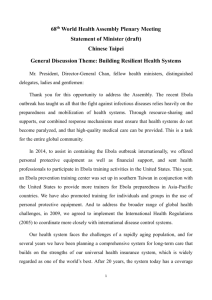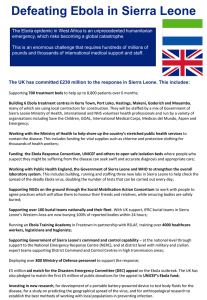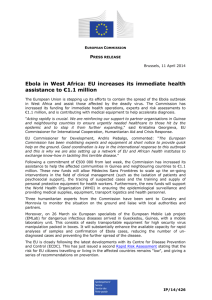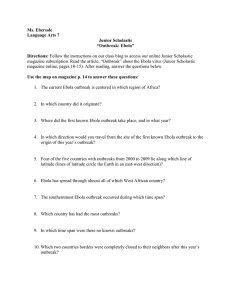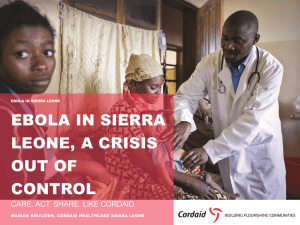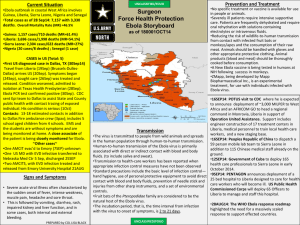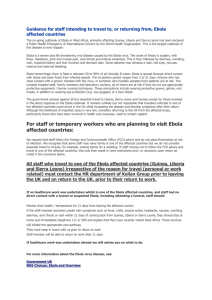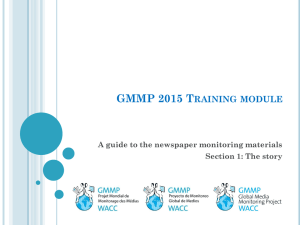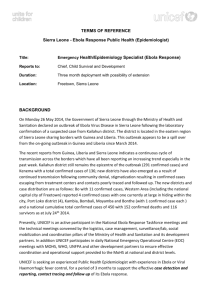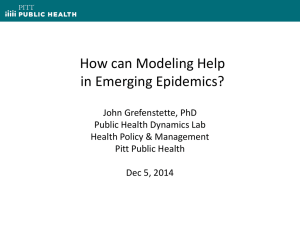The Impact of EVD on Africa (Draft )
advertisement
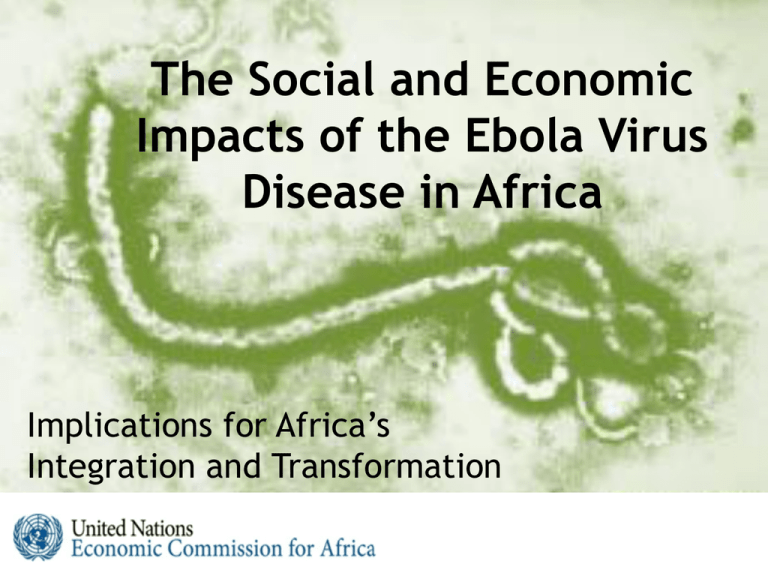
The Social and Economic Impacts of the Ebola Virus Disease in Africa Implications for Africa’s Integration and Transformation The need for an assessment • Meaningful full assessment can only be done once the outbreak is contained • The assessment shall Short term • Contribute to the dissemination of countrybased primary information on the epidemic and its implications • Support ongoing economic and social planning efforts that accompany the current health response Medium and long term Contribute to the preparation of countries’ policy responses for the post epidemic recovery Understanding the Continental Consequences of the Ebola Outbreak ECA will position the current Ebola outbreak in a continental context and assess the social and economic impact that it can have on Africa’s integration and transformation The purpose is to analyze prospectively the ripples that the pandemic can have on productive sectors, social protection, health and educational outcomes, beyond the immediate impact in lives A Gap Assessment on Knowledge Study and geographical focus Dimensions/variables Methodology covered -GDP; -fiscal World Bank - Economic impact the effect/financing gap; 3 affected countries; short term inflation; -investment; and medium term study capital flight; exchange rate Ebola led to downward revision of the 2014 Sector components Model growth of Liberia (from 5.9% to 2.5%), Sierra which allows experimenting Leone (from 11.3% to 8%) and Guinea (from with various scenarios (e.g. 4.5% to 2.4%). The growth prospects for 2015, low Ebola and high Ebola) respectively, are -4.9%, 3% and 2%. UNDP (Sierra Leone / Guinea Economic and social impact WHO (the affected countries; 9 months of Ebola and projection to November 2014) Health and health systems (New England J. of Forecasting tools Medicine) World Association of Universities West Africa Impact on higher education The Economist (Ebola’s economic impact-September 3) Health, education, trade and growth WFP (Rapid Assessment)- Senegal CDC (estimating the scale of EVD) Results Narrative analysis (Sierra Leone) of several sectors Multisectoral Consequences 70.8% fatality rate; If not treated the # of Ebola cases will be 20,000 in all countries. Data from various universities for descriptive analysis -negative for the higher education sector; Knowledge workers are being withdrawn. - GDP declines, food shortage, supply of teachers decreases, decline in savings, investment/capital accumulation Trade Rapid appraisal 50% drop in cross-border trade, fruit and palm oil no longer available on border markets with Guinea Prevalence of EVD Computational and other modelling tools 8,000 cases in S. Leone; `16,000 cases in Liberia; 550,000 cases without intervention; 1.4million by January FDC (finance derivatives company)- Tourism; Aviation ; Health; making economic sense of Ebola Agriculture Social Consequences Decrease on Health Outcomes Incremental Costs to Health Systems Incremental Dropouts Reduced School Attendance Increased Pressure on Health Systems Intra African and Intercontinental Trade Incremental Costs to Governments and Society Migration Decrease in Educational Outcomes Economic Consequences Africa's Integration and Transformation Reduced Outcomes on Social Protection Household Income, Food and Nutrition Agricultural Industry Mining Knowledge Transfer / Meetings Not tending to Regular Pathologies – malaria, vaccinations, etc. Changes in Production Patterns Transport Trade Tourism Changes in Capital Flows Gender Increased Morbidity Increased Mortality Increased Labor Absenteeism Changes in Domestic Consumption Patterns Changes in International Consumption Patterns Investment Patterns Ebola Virus Disease Outbreak Cohesion Stigma Governance / Security Risk Perceptions Uncertainty Methodology -Sector Specific Analysis with a Holistic Approach Health Education Social Protection Labor Trade Agriculture Financial Flows Commerce Gender Increasing resiliencies from all sectors • Priority: focusing on the emergency (current health response) as it will impact all sectors of the economy • The need for policy responses in all affected sectors Collaboration at Several Levels Country UNDP & Other UN Partners Regional UNDG Continental ECA Time Line September • Establishment of Interdivisional TaskForce at ECA AUC Summit January 2015 – November • Zero Draft Report October December • Methodological Development • Field Mission • Draft Report •Presentation of Initial Results

